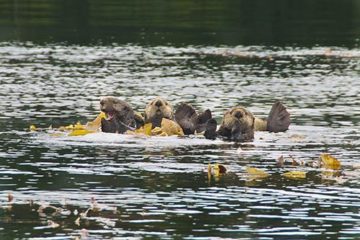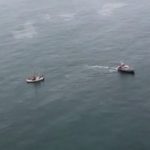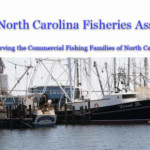Tag Archives: U.S. Fish & Wildlife Service

The Illegal Black Market – Abalone haul costs man $500,000
A Chula Vista man who owns a seafood company was fined $15,000 Dec. 18 and ordered to forfeit $500,000 in proceeds stemming from his illegally importing abalone from Mexico without specifying from where it came. Yon Pon Wong, 65, the owner of the Lucky Company, pleaded guilty to false labeling in the U.S. in which he sold 148,500 pounds of abalone and falsely stated where he obtained it. click here to read the story 17:46
How Maine came to play a central role in an international eel smuggling scheme
 Years after officials launched an investigation into baby eel poaching on the East Coast, the first of several men to plead guilty to participating in the wildlife trafficking ring was sentenced last week in a federal courtroom in Maine. Michael Bryant, 40, a former Baileyville resident who now lives in West Yarmouth, Massachusetts, is one of more than a dozen men who the U.S. Fish & Wildlife Service says poached thousands of pounds of the baby eels, also known as elvers or “glass” eels, from 2011 through 2014. Since 2011, elvers on average have fetched around $1,500 per pound for fishermen, and netted more than $4 million total for the 12 convicted poachers who have pleaded guilty to federal charges in South Carolina, Virginia and Maine. Maine found itself at the center of a criminal enterprise that illegally netted elvers along the Atlantic seaboard, where most states ban their harvesting, and then shipped the eels overseas to feed East Asia’s voracious seafood appetite, according to investigators. click here to read the story 14:43
Years after officials launched an investigation into baby eel poaching on the East Coast, the first of several men to plead guilty to participating in the wildlife trafficking ring was sentenced last week in a federal courtroom in Maine. Michael Bryant, 40, a former Baileyville resident who now lives in West Yarmouth, Massachusetts, is one of more than a dozen men who the U.S. Fish & Wildlife Service says poached thousands of pounds of the baby eels, also known as elvers or “glass” eels, from 2011 through 2014. Since 2011, elvers on average have fetched around $1,500 per pound for fishermen, and netted more than $4 million total for the 12 convicted poachers who have pleaded guilty to federal charges in South Carolina, Virginia and Maine. Maine found itself at the center of a criminal enterprise that illegally netted elvers along the Atlantic seaboard, where most states ban their harvesting, and then shipped the eels overseas to feed East Asia’s voracious seafood appetite, according to investigators. click here to read the story 14:43
Judge Lets East Sand Island Cormorant Cull Continue
 A federal judge will allow the Army Corps of Engineers to keep shooting native cormorants by the thousands, to reduce predation on young salmon, despite objections from environmentalists who say the slaughter doesn’t address the real cause of dwindling salmon populations: hydroelectric dams. The Audubon Society of Portland led an April 2015 lawsuit against the Corps of Engineers and the U.S. Fish & Wildlife Service, claiming that the plan scapegoated a natural predator and had little effect on survival rates of young salmon. Chief among the Audubon Society’s arguments is that there are so many factors that determine whether a salmon will return from sea to spawn in its native waters that the government’s focus on cormorant predation was not only fruitless, but hurt a native bird protected by the Migratory Species Act. The government’s plan focused on East Sand Island, home to the largest breeding population of double-crested cormorants in North America. The 60-acre island is nestled in the fertile brackish waters where the Columbia River empties into the Pacific Ocean. Read the rest here 14:11
A federal judge will allow the Army Corps of Engineers to keep shooting native cormorants by the thousands, to reduce predation on young salmon, despite objections from environmentalists who say the slaughter doesn’t address the real cause of dwindling salmon populations: hydroelectric dams. The Audubon Society of Portland led an April 2015 lawsuit against the Corps of Engineers and the U.S. Fish & Wildlife Service, claiming that the plan scapegoated a natural predator and had little effect on survival rates of young salmon. Chief among the Audubon Society’s arguments is that there are so many factors that determine whether a salmon will return from sea to spawn in its native waters that the government’s focus on cormorant predation was not only fruitless, but hurt a native bird protected by the Migratory Species Act. The government’s plan focused on East Sand Island, home to the largest breeding population of double-crested cormorants in North America. The 60-acre island is nestled in the fertile brackish waters where the Columbia River empties into the Pacific Ocean. Read the rest here 14:11
California’s Shellfish Industry Fight to Restore Otter-Free Zone
 California’s shellfish industry fought the federal government’s termination of a “no-otter zone” along the Southern California coast at a Ninth Circuit hearing on Friday. Four fishing industry groups sued the U.S. Fish & Wildlife Service in 2013, claiming its decision to end a long-disputed sea otter translocation program would “severely compromise if not destroy” shellfish and other marine fisheries on the southern coast. Nixing the program would lead more than 300 sea otters to occupy a previously “otter-free zone” within 10 years and prey on the shellfish which fishermen depend on for their livelihood, the plaintiffs claimed in their 2013 complaint. But environmental groups had long pushed for the government to end the program, claiming it was a disaster from the start and that it bowed to the interests of the oil and fishing industries. Read the rest here 07:58
California’s shellfish industry fought the federal government’s termination of a “no-otter zone” along the Southern California coast at a Ninth Circuit hearing on Friday. Four fishing industry groups sued the U.S. Fish & Wildlife Service in 2013, claiming its decision to end a long-disputed sea otter translocation program would “severely compromise if not destroy” shellfish and other marine fisheries on the southern coast. Nixing the program would lead more than 300 sea otters to occupy a previously “otter-free zone” within 10 years and prey on the shellfish which fishermen depend on for their livelihood, the plaintiffs claimed in their 2013 complaint. But environmental groups had long pushed for the government to end the program, claiming it was a disaster from the start and that it bowed to the interests of the oil and fishing industries. Read the rest here 07:58
Endangered winter-run Chinook Salmons fingerlings released into Sacramento River

Chatham still fighting U.S. Fish & Wildlife Service for control of fisheries in Monomoy National Wildlife Refuge
 The town is primarily opposed to proposals in the plan that exert federal control over fisheries, in the coastal waters that fall within refuge boundaries, that typically were managed under state and town regulations, and with the taking of 717 acres of South Beach that Chatham claims is town property. The Monomoy plan sought to ban certain types of fishing they believed damaged the bottom habitat, including scallop, clam and mussel dredging, using a towed net to catch fish and fish weirs. Read the rest here 07:45
The town is primarily opposed to proposals in the plan that exert federal control over fisheries, in the coastal waters that fall within refuge boundaries, that typically were managed under state and town regulations, and with the taking of 717 acres of South Beach that Chatham claims is town property. The Monomoy plan sought to ban certain types of fishing they believed damaged the bottom habitat, including scallop, clam and mussel dredging, using a towed net to catch fish and fish weirs. Read the rest here 07:45
Atlantic States Marine Fisheries Commission proposes new rules for American eel
The commission is considering 25 options for revising regulations for commercial fishing for glass, yellow and silver eels, from keeping the status quo to permitting aquaculture with permits to new catch limits. Read more here 11:09
Elver investigation brings federal officials to Ellsworth
 Law enforcement officials with the federal agency, along with others from the National Oceanic and Atmospheric Administration and Maine Marine Patrol, were in Ellsworth early Thursday morning as part of the investigation, according to fishermen and local officials. Read more here 07:34
Law enforcement officials with the federal agency, along with others from the National Oceanic and Atmospheric Administration and Maine Marine Patrol, were in Ellsworth early Thursday morning as part of the investigation, according to fishermen and local officials. Read more here 07:34
The Downeast Salmon Federation hopes ‘planting’ salmon eggs in rivers will restore population
 The technique simulates natural activities of salmon reproduction. A female salmon creates a nest, called a redd, in the gravel of a streambed or riverbed in the fall. Using her tail, the fish scoops out a pit, lays her eggs, then covers them with gravel to protect them until they hatch in the spring. Read [email protected] 08:05
The technique simulates natural activities of salmon reproduction. A female salmon creates a nest, called a redd, in the gravel of a streambed or riverbed in the fall. Using her tail, the fish scoops out a pit, lays her eggs, then covers them with gravel to protect them until they hatch in the spring. Read [email protected] 08:05
U.S. Fish & Wildlife Service unveil vast, $1.24 billion 50-year tidal marsh restoration plan for San Francisco Bay

FREMONT, Calif. — A 50-year plan for the restoration of San Francisco Bay and other coastal wetlands was released Thursday by federal wildlife officials who say it’s the biggest effort to save tidal marshes outside the Florida Everglades. more@wapo 18:17
Year one of Eastport tidal turbine research presents challenges
 EASTPORT, Maine — Months of underwater testing in Cobscook Bay of experimental, tidal-based electrical generation technologies were not without its challenges, according to a research report recently filed with the Federal Energy Regulatory Commission. continued
EASTPORT, Maine — Months of underwater testing in Cobscook Bay of experimental, tidal-based electrical generation technologies were not without its challenges, according to a research report recently filed with the Federal Energy Regulatory Commission. continued
Officials: Elver eel season stunted by low temperatures, prices – Fishery in the government crosshairs!
 ELLSWORTH, Maine — The 2013 elver fishing season in Maine has begun with cooler temperatures and cooler prices, according to a state official. “They’re a little bit on the spotty side,” Separate from the Atlantic States Marine Fisheries Commission process, the U.S. Fish & Wildlife Service is considering listing American eels under the federal Endangered Species Act, which could result in a ban on all American eel fishing. continue reading
ELLSWORTH, Maine — The 2013 elver fishing season in Maine has begun with cooler temperatures and cooler prices, according to a state official. “They’re a little bit on the spotty side,” Separate from the Atlantic States Marine Fisheries Commission process, the U.S. Fish & Wildlife Service is considering listing American eels under the federal Endangered Species Act, which could result in a ban on all American eel fishing. continue reading















































